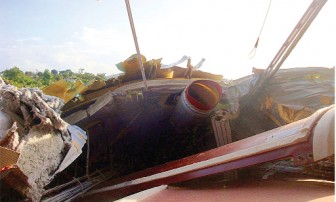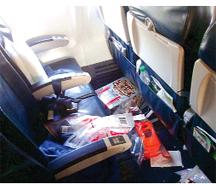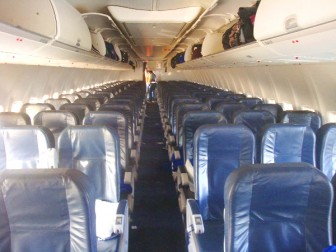Preliminary investigations point to pilot error as the main contributing factor to Caribbean Airlines Flight 523 overshooting the runway at the Cheddi Jagan International Airport (CJIA) with information from the flight recorders as well as marks on the runway confirming that the jet touched down close to halfway along the length of the runway, a source close to the probe has revealed.
The preliminary investigations thus far have also indicated that air traffic control at CJIA is more than likely in the clear and poor visibility was also ruled out, the source told Stabroek News yesterday. Minister of Transport and Hydraulics, Robeson Benn, in a statement to the National Assembly yesterday, also stressed that visibility was good last Saturday when the plane crashed-landed.

At about 1:32am on Saturday, CAL Flight 523 overshot the runway at the CJIA and hurtled through the perimeter fence of the airport before the jet broke in two. There were 162 passengers and crew onboard the Boeing 737-800 aircraft at the time of the crash. There were no fatalities.
The source told Stabroek News yesterday that the preliminary investigations revealed that the aircraft had touched the runway surface close to halfway down the length of the main Runway O6 at the CJIA. The source said that the US National Transportation Safety Board inspectors along with investigators of the Guyana Civil Aviation Authority (GCAA) discovered that the jet made initial contact with the 7500 feet long runway surface, opposite the viewing gallery at the terminal building.

The aircraft touched down between two taxiways codenamed Alpha and Bravo. Both taxiways are located in front of the terminal building and aircraft such as the Boeing 737 would normally exit the runway via the two taxiways which are located parallel to the runway in question. As such investigations are “more than likely” to point to pilot error being the main contributing factor to the incident, the source said. The point of touchdown was confirmed based on marks observed on the runway surface immediately after the incident as well as information provided by the black box recordings which are currently being analyzed, the source said.
The distance at which the touchdown was made coincides with several passenger and observer accounts given after the incident.
The aircraft, registered 9Y-PBM in Trinidad and Tobago, is being combed as investigations are on-going and it is expected to be relocated to the old Guyana Airways Corporation hangar, located at the north western part of the airport next week.
Meanwhile, Benn, in a statement to the National Assembly yesterday on the crash, said that government is concerned at various media reports that sought “to discredit and vilify the physical and operational environment at the Cheddi Jagan International Airport, particularly at the time of the accident.”

“Descriptions of the prevailing weather conditions and the state of the runway at the time of the accident and the timeliness of the emergency response personnel are issues that have been sensationalized in certain sections of the media both nationally and overseas apparently without any attempts at basic and proper investigative journalism,” Benn said.
He said that the Guyana Fire Service responded less than three minutes after being notified of the crash and proceeded to apply foam to the aircraft and facilitate the removal of passengers from the aircraft. “I have seen firsthand video footage from the airport security cameras which recorded the airport fire service responding within 3 minutes of the receipt of the emergency call,” he declared. “Indeed Madame Speaker, it was the Guyana Fire Service personnel who laid down foam to the aircraft #2 engine,” the minister said adding that officials also assisted persons in leaving the plane. Several other officials, including airport security responded to the crash, he said.
One of the survivors of the crash had told Stabroek News that she saw at least four fire-fighters looking down at her and the others from the edge of the runway, but says they offered no help as more that 150 screaming passengers scrambled to exit the smoking wreckage.
Benn also outlined the conditions just before the CAL flight landed at the CJIA. He said that reports from the Hydrometeorologi-cal office at Timehri, which is equipped with a modern Doppler system, indicated that there was a light drizzle at the time of the accident, calm winds and no fog. According to him, the visibility was at 8 km with a cloud ceiling of 9000 feet. Benn said that thirty minutes before the accident, the total amount of rainfall reported was 1.8 mm. According to him, there was no possibility of stagnant water on the runway. He said that there was no problem with either the lighting or the runway.
He said that initial investigations are being wrapped up. “Four of five teams have concluded preliminary investigations and are in the process of concluding preliminary reports,” he said.





